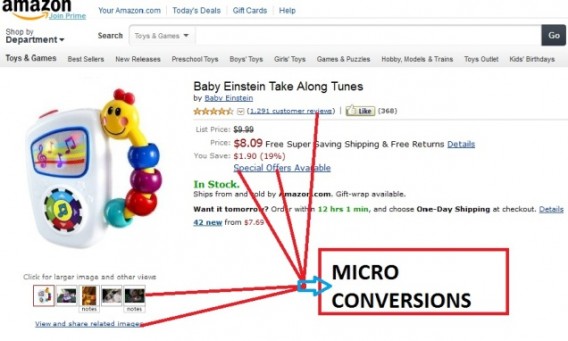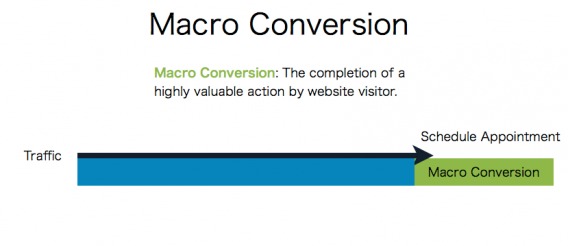If we’re supposed to optimize what’s closest to the money, what is the value in optimizing for micro conversions?
Many blog posts have espoused this as a way to incrementally increase revenue and final conversions, but does tweaking stuff unrelated to purchase actually assist your bigger goals?
There are many different opinions on this question.
Table of contents
What Are Micro Conversions?
Micro conversions are actions a user completes that are either on the path to revenue-generating conversions or not directly related to revenue generation.
What does that mean in practice? Micro conversions, depending on your business-type, could be any of the following:
- Viewing your “Request a Quote” page
- Visiting the checkout page
- Clicking the ‘View pricing’ link
- Adding a product to the cart
- Commenting on an article
- Watching an explainer video
…and on and on. There are tons of micro conversions you can track, just know that they are things not directly related to the final goal on your site, whatever that may be.
Bryan Eisenberg wrote about micro conversions (or micro-actions) as early as 2001. According to Eisenberg, “conversion rates suffer when sites fail to drive customer micro-actions and maintain momentum through the sales path. Once the path is defined and each of the micro-actions described, you can work on optimizing the most effective call to action for each step.”
He describes micro conversions as opportunities to patch up holes in the leaky bucket of your website, and in the process, increase your macro conversions and revenue.
We can actually further divide micro conversion into two functional categories. According to NN/g, the two types are:
- Process Milestones – these are the conversions that tend to lead to a primary macro-conversion. According to NN/g, “monitoring these will help you define the steps where UX improvements are most needed.”
- Secondary Actions – there aren’t primary goals of the site, and they aren’t linearly related to the primary conversion. They are, however, desirable actions that usually indicate a potential future macro-conversion.
In You Should Test That!, Chris Goward similarly categorized micro conversions as:
- Micro-step conversions (add-to-cart, visit to quote form, etc)
- Micro-indicator conversions (whitepaper download, social media interaction, etc)
Different terms for the same thing, really.
Process Milestones
Process milestones lead a user towards a macro-conversion. They are incremental steps, such as placing a product in the cart, or viewing the pricing page, that users must accomplish before they make the final purchase.
The benefit of tracking process milestones is in the segmentation of the customer journey. Instead of an opaque journey to a final purchase, you’re able to witness falling-off points and bad usability, and fix them. Here’s how Jennifer Cardello from NN/g put it:
“If you are running experiments to test design changes within steps of a process or a linear interaction, looking for statistically significant changes in macro-conversion rates can be fruitless and can lead to discarding good design ideas. In an environment where users undertake multiple actions to eventually reach a macro-conversion event, there are many junctions at which the design can be improved. Micro conversions help identify where UX improvements are most needed. They also help us determine if UX changes are having the desired impact.”
For example, if there’s a large drop off in any one step, the goal with tracking micro conversions is that you can run tests to fix that particular thing. Here’s an example of Amazon’s mobile checkout flow, all leading up to a macro-conversion (purchase):

Secondary Actions
Secondary actions are a little different. They don’t explicitly lead to a purchase, but they are indicators of interest that tend to build trust and credibility with your brand. Some examples of secondary actions could include:
- Commented on a blog post
- Subscribed to your newsletter
- Watched a webinar
Tweeted content - Checked out a white paper
- Viewed 3 (or whatever number) of pages
For example, you don’t have to download an e-book to start using Optimizely’s testing tool. However, by doing so, you’re indicating your trust and interest in the brand.
The hope, then, is that you’ll eventually make that macro-conversion and become a paying user of the product.
What About Macro Conversions?
I’ve already explained macro conversions in passing, but to define more thoroughly: Macro conversions are the main conversion goal of your website – the goal action that is most closely tied to revenue. As Kevin McCaffrey put it, where secondary conversions are business supporting conversions, primary conversions are business driving conversions.
So if you’re running an ecommerce site, a macro-conversion would be a completed order. If you’re doing lead generation for sales, then a completed lead form would be a macro conversion. SaaS? A free trial sign-up, as well as a paid upgrade, would be macro conversions. They all tie directly to the money.
Don’t Obsess Over “Conversion Rates”
Obsessing over conversion rates in general might be confusing the whole macro vs micro debate. What matters is growth, not optimizing for conversions. As Peep always says, “Revenue matters, conversions don’t. If you want higher conversion rate, just cut your prices in half!”
So what if you increase conversions on a supporting step, but it doesn’t lead to an increase in RPV? If it keeps your revenue stagnant, increasing your micro conversions doesn’t really mean much.
Lukas Vermeer put it well in a previous blog post:

Lukas Vermeer
“Pick the right metric.
This question is not about testing strategy, but about business objectives. If your business relies on repeat payments, conversion rate is probably not the right metric to optimise for; just like CTR is terrible for optimising hotel bookings (e.g. EMK with subject “FREE BEER” will improve CTR, but probably reduce sales once customers figure out there is no beer on your site, certainly not free beer).
You should probably look at more longer term metrics, such as signups that stay customer for 3 months+.”
Avinash Kaushik wrote about conversion rates as a metric a while back, explaining that there are a lot of other things to track to measure the health of your business:

Avinash Kaushik
“My recommendation is that you should stop obsessing about conversion rate, put Overall Site Conversion Rate in some appendix of your weekly / monthly presentations but that is about it.
So what might you be missing if you only focus on conversion rate?
- Customers who will come to your website to “research,” product specific. They will never buy from your website, maybe if you do a awesomely kick butt job on the website maybe you will convert them but it is highly unlikely. An example of this is you/me using Amazon to primarily read customer reviews or watch the new Bill Maher show, or wanting to read specs or print web pages with product information.
- Customers who will come to your website to “learn” about you, the company. They are looking for jobs, they are looking for press releases, they are looking for your company founders bio, they are looking for why you exist, they want your blog, they want to unsubscribe from your emails etc.
- Customers who come to our websites for “help”. This is people looking for support or looking for driving directions to your office or they want to send you a nasty email or register their product etc.
- Customers who come for reasons that we don’t know simply because we simply never bothered to ask (this is huge by the way).”
In any case, conversion rates can be misleading if you’re focused on the wrong ones – especially the ones that aren’t tied to your final conversions or RPV.
Tracking Micro Conversions vs. Testing Micro Conversions
Be careful when you read blog posts about micro conversions because there’s a big difference between tracking them in your analytics tool and optimizing in attempt to increase them exclusively.
It’s beneficial to track micro conversions for the reasons stated above. It offers a holistic picture of your user experience, and it allows you to break down which parts of your website are stopping-points.
Forming test hypotheses specifically to increase pageviews per user is different than analyzing that piece of data in correlation with the overall revenue per visitor per segmentation.
Another reason tracking micro-conversion is important is that not all of your visitors convert the first time. Most of them don’t. Avinash Kaushik wrote a great post on this subject. In it, he said:

Avinash Kaushik
“But what do you do in terms of measuring complete success of your website? All that white “space” (Unique Visitors) wasted for nothing?
No. Well maybe some.
But people don’t just come to your site to Buy. They are there to Research products and services (and buy offline). They are looking to get Support. They are there for looking for Jobs. They might be there to look at your latest Blog Post, etc.
Make each one of those your Micro Conversions.”
Tracking Micro Conversions Allows Greater UX Insight
He explained this really well by giving an example of a photo sharing website with a conversion rate of 1.72%:
Not bad, but the founder also wants to track micro conversions. In this case, he’s tracking things that lead up to a final conversion or build brand credibility (registrations, members publishing photos, people who sign up for premium content, and people who sign up for announcements):
This, according to Kaushik, represents a more holistic picture as to the health of the site. NN/g agreed, saying:
“Micro conversions provide essential visibility into the holistic user experience. Focusing solely on macro-conversion measurement risks adopting only design and content changes that result in instant, large shifts in conversion rate. These shifts are often short lived. Sites that optimize for long-term returns need to focus on all the components that provide a positive user experience and business return over time.”
Should You Optimize for Micro Conversions?
So, tracking micro-conversion metrics is beneficial. But what about optimizing for micro conversions? Most of the time – without keeping the large goals at the front of your mind – that’s not a good idea.
The most common reason people want to optimize for micro-conversion is that it speeds up the testing process. As such, it is often low traffic sites (e.g. startups) that want to optimize for micro conversions.
The length of time needed to run your A/B test depends on the level of traffic and conversions you get. Of course, you’ll get more micro conversions that final conversions in most cases (e.g. more people will click ‘add-to-cart’ than will move on to purchase, logically).
Here’s how Jakub Linowski from goodui.org put it (also, check out this post where he outlines metric depth):

Jakub Linowski
“One benefit of setting a proper depth for the primary metric, is that it allows us to design the test so that we can actually detect significant results, instead of wasting time. Usually, the further we move along the spectrum of depth, the harder it is to measure and obtain a significant result. Meanwhile, the shallower the metric, the less intent they might express.
Yes, clicking on a “Learn More” button might not always correspond to more sales (although sometimes it might). But, perhaps measuring visits to Payment Pages or clicks on a deeper “Buy Now” button (before validation) might correspond to true purchases quite well. We try to set our primary metrics as deep as possible, to a point that we can actually measure them, aligned to what the site traffic permits.”
Though, sometimes optimizing for top-of-the-funnel micro conversions can be misleading, even detrimental, to your revenue. Chris Goward of WiderFunnel gave a great example of how this can happen. So, imagine you have a typical gated form that a software company uses to generate leads for a sales team. The conversion funnel might look like this:
From there we move on with the assumption that, if the home page gets 100,000 visitors monthly, the counts for each other page in the scenario could be:
- Download Page: 20,000
- Gate with Form: 15,000
- Thank-you Page: 5,000
You have to decide which of the following your experiment goal will be:
- visit to the download page
- visit to the gate page
- download completion.
Because the download page gets 20k visitors a month, you might be tempted to test that because you can get an experiment done faster. However, that might be a mistake.
The false assumption most people make is that the funnel dropoff will be the same on each variation. Many times, that’s not the case. Here’s the example that WiderFunnel gave:
As you can see, there are different winners depending on which goal you’re tracking. Even though variation C would have won on the micro-conversion level of getting to the download page, it was the worst variation in overall completed conversions.
Had you optimized for micro conversions, you would have lost revenue.
Here’s how Chris Goward summed it up:

Chris Goward
“For Conversion Optimization, you should always set your test goal as close to revenue as possible. Optimize for direct sales, average order value and qualified leads generated.
Please continue to look at micro conversions in your web analyses, but for Conversion Testing, stick to revenue-producing goals.”
There is, of course, a balance here – a way to mitigate the risk of a potential revenue loss while increasing volume to a micro-goal in the funnel. Justin Rondeau from Digital Marketer gives a great example:

Justin Rondeau
“In most cases sites with lower traffic should use other optimization techniques outside of micro conversions, but if they are testing micro conversions could help give their test more depth.
Say an ecommerce site can’t test their cart page because there are way too few conversions for an adequate sample size, but their product page gets enough traffic for a clean test. This turns into a volume game. Run a test on the product page where add-to-cart is the immediate conversion metric and then monitor sales. If one product page variation beats out the other and the sales conversion rate is at the very least consistent between the two variations, I’d consider that test a win based on volume to the offer alone.
Best case scenario is you increase both volume and the sales conversion rate increases. However, you’d never know this if you didn’t measure both the micro and macro conversion.”
Do Micro Conversions Correlate With a Revenue Increase?
Okay, so that’s just one hypothetical example. In general, do micro-conversion increases correlate with increased revenue generation?
The answer here is complicated, of course. Here’s how Jakub Linowski from goodui.org put it:

Jakub Linowski
“Does increasing mico-conversions correlate with increasing revenue? Sometimes yes, sometimes no. We’ve seen various patterns form as we measured depth: gradual up curves (did not push people to act initially, but increased deeper intent), gradual down curves (did push people artificially to act initially, but did not increase true intent), correlating (pushed people to act, and increased intent equally), and random (all over the place, insignificance noise).”
However, if you’re only testing for micro conversions and you don’t have enough transaction volume, it’s difficult to see the impact on the larger goal of improving macro-conversions. Here’s how Peep put it:

Peep Laja
Don’t optimize for micro conversions. Improving those numbers can’t be your final goal. And without measuring macro-conversions you won’t know whether more cart adds will result in more purchases, or just moves some of the drop-offs to the next funnel steps.
If you don’t have enough transaction volume to measure final purchases or revenue, that sucks. But if you now optimize for micro conversions instead, you might be just wasting everyone’s time since you can’t really measure business impact.
Now there are instances where I would declare a test treatment as a “winner” based on micro conversions, but then the improvement in the rest of the funnel needs to be very high (e.g. +50% or more) – without making hyperbolic or false claims.”
The “Free Beer” Illusion
Here’s a test: replace your ‘schedule a demo’ CTA with copy that reads “Click here for free beer”
While you may very well increase your click through, you’re simply shifting the problem to the next step of the funnel. They’re still gonna drop out of the funnel (probably at a higher rate because of the message mismatch).
Optimizing for micro conversions can lead you to believe that you’re making progress, when in actuality you’re shuffling papers, shifting things around and never solving the true problems with your website.
To put it another way, I could change all of my Tinder pictures and bio to that of Ryan Gosling. If my potential matches believed that I really was Gosling (not likely, but stick with me), I’m sure my matches (micro conversions) would increase precipitously. But as soon as my matches find out that I am not, indeed, Ryan Gosling, my bottom of the funnel conversions will most certainly tank.
Of course, these are both extreme examples based on deception, yet they both show how, with a little message misalignment, you can increase micro conversions while simply pushing the product further down the funnel.
Conclusion
The simplest advice to give would be to measure your micro conversions, but don’t optimize for them as you won’t know if it has any positive business impact or not.
While they can inform the greater good of your website, myopically focusing on one small step of the funnel can sometimes have the adverse effect of decreasing revenue. In other cases, sometimes it just simply moves the problem to the next page, so you’re basically shuffling papers and wasting time.
Avinash Kaushik said it well: “Focus on measuring your macro (overall) conversions, but for optimal awesomeness identify and measure your micro conversions as well.”
At CXL, we measure our micro conversions of course. But only alongside the things that matter, as another method of informing us with UX insights. In the end, if what you’re optimizing doesn’t move the needle (CR or RPV), you’re not really optimizing anything. I think Justin Rondeau from Digital Marketer summed it up really well here:

Justin Rondeau
What’s important is you shouldn’t lose sight of the overall campaign goals when measuring micro conversions. A micro-conversion lift doesn’t entail a lift in revenue, so make sure to have the long view.”













Great read… The A/B testing is definitely an idea to keep in mind.
When it comes to contact forms and lead generation on websites, its important to ensure your online forms are always working.
Till today, i was carrying a vague idea about micro and macro conversions.
After going through this article thoroughly now I can say that I have a sound knowledge about micro and macro conversions :)
It’s really a great and informative article.
Cheers!!
Great read. And fantastic use of myopically!
With Google focusing so much on “micro-moments” and analytics not giving you the ability to easily separate the micro and macro conversions from each other, this is a great idea for a post.
Primarily working with automotive dealers, they are not interested in how many people viewed their hours and directions page…they want calls and emails. What we try to do, and what is extremely hard to determine, is work backwards and find the micro conversions that correlated better to macro conversions.